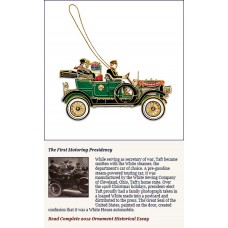The White House Historical Christmas Ornament William Howard Taft - 2012
Availability: In Stock
Add to Compare
$30
The 2012 White House Christmas Ornament honors President William Howard Taft who introduced the automobile to White House transportation in 1909, breaking a long presidential tradition of reliance on horse-drawn vehicles. It celebrates President Taft's adoption of the automobile, his love of manufacture and invention, and his ready acceptance of modernity.
The ornament depicts President and Mrs. Taft enroute to deliver Christmas presents. They are seated behind chauffeur George H. Robinson in the White Motor Company's Model M, a seven passenger steam-powered touring car embellished with the Great Seal of the United States on the doors. The color, as described at the time, is "a harmonious blend of subdued greens."
The ornament is made in the United States of highly-polished brass with a coating of nickel finished in 24K gold.
................................................
Our 27th President William Howard Taft
William Howard Taft Distinguished jurist, effective administrator, but poor politician, William Howard Taft spent four uncomfortable years in the White House. Large, jovial, conscientious, he was caught in the intense battles between Progressives and conservatives, and got scant credit for the achievements of his administration.
Born in 1857, the son of a distinguished judge, he graduated from Yale, and returned to Cincinnati to study and practice law.
He rose in politics through Republican judiciary appointments, through his own competence and availability, and because, as he once wrote facetiously, he always had his "plate the right side up when offices were falling." But Taft much preferred law to politics. He was appointed a Federal circuit judge at 34. He aspired to be a member of the Supreme Court, but his wife, Helen Herron Taft, held other ambitions for him.
His route to the White House was via administrative posts. President McKinley sent him to the Philippines in 1900 as chief civil administrator. Sympathetic toward the Filipinos, he improved the economy, built roads and schools, and gave the people at least some participation in government.
President Roosevelt made him Secretary of War, and by 1907 had decided that Taft should be his successor. The Republican Convention nominated him the next year. Taft disliked the campaign--"one of the most uncomfortable four months of my life." But he pledged his loyalty to the Roosevelt program, popular in the West, while his brother Charles reassured eastern Republicans. William Jennings Bryan, running on the Democratic ticket for a third time, complained that he was having to oppose two candidates, a western progressive Taft and an eastern conservative Taft.
Progressives were pleased with Taft's election. "Roosevelt has cut enough hay," they said; "Taft is the man to put it into the barn." Conservatives were delighted to be rid of Roosevelt--the "mad messiah." Taft recognized that his techniques would differ from those of his predecessor. Unlike Roosevelt, Taft did not believe in the stretching of Presidential powers. He once commented that Roosevelt "ought more often to have admitted the legal way of reaching the same ends."
Taft alienated many liberal Republicans who later formed the Progressive Party, by defending the Payne-Aldrich Act which unexpectedly continued high tariff rates. A trade agreement with Canada,
which Taft pushed through Congress, would have pleased eastern advocates of a low tariff, but the Canadians rejected it.
He further antagonized Progressives by upholding his Secretary of the Interior, accused of failing to carry out Roosevelt's conservation policies. In the angry Progressive onslaught against him, little attention was paid to the fact that his administration initiated 80 antitrust suits and that Congress submitted to the states amendments for a Federal income tax and the direct election of Senators.
A postal savings system was established, and the Interstate Commerce Commission was directed to set railroad rates.
In 1912, when the Republicans renominated Taft, Roosevelt bolted the party to lead the Progressives, thus guaranteeing the election of Woodrow Wilson.
Taft, free of the Presidency, served as Professor o f Law at Yale until President Harding made him Chief Justice of the United States, a position he held until just before his death in 1930. To Taft, the appointment was his greatest honor; he wrote: "I don't remember that I ever was President."
Write a review
Your Name:Your Review: Note: HTML is not translated!
Rating: Bad Good
Enter the code in the box below:





